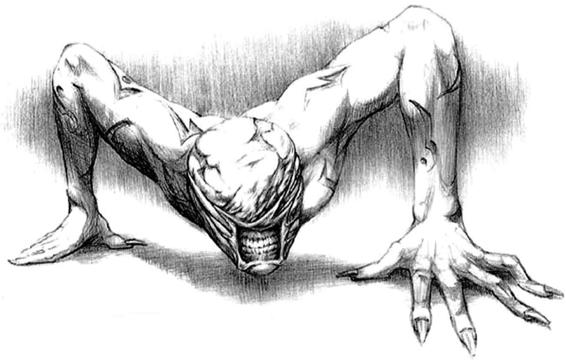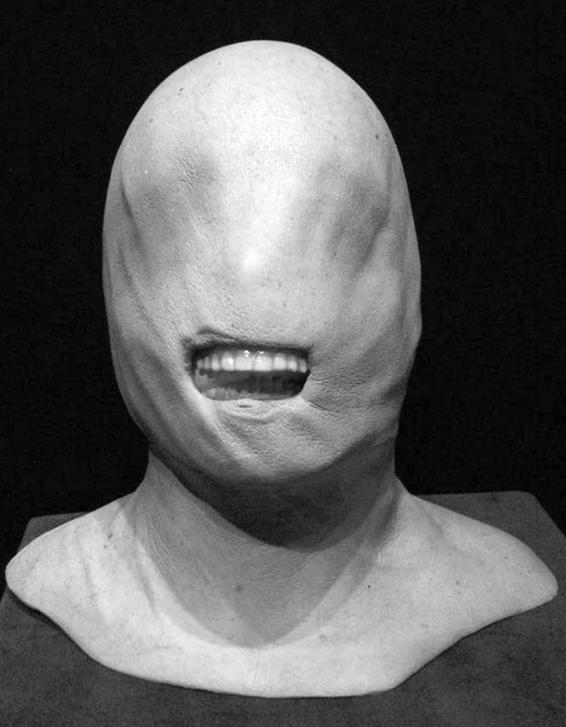The Hellraiser Films and Their Legacy (38 page)

Or perhaps still bides its time in the shadows ...
Concurrently there were moves to put the original
Hellraiser
onstage in the West End. Barker gave his blessing to the theatrical production, which was due to open around May 1999, and Doug Bradley was approached to play Pinhead again. A veteran theatre actor, the only thing that bothered him would be the make-ups every night, but as he told Nick Joy, “The bottom line is I don’t want some other bugger doing it. I can’t face the thought of someone else opening the show in the West End or taking it all over to Broadway.”
1
Banking on a fresh start for the celluloid series, Miramax producers eventually settled upon the creative team of Scott Derrickson and Paul Harris Boardman. The pair met at USC’s film school where Boardman wrote and directed
The Roof
, a short film that won a CINE Eagle Award and several festival prizes. Derrickson edited the project and became quite a fan of his friend’s writing, so much so that he asked Boardman to co-write his own thesis film: a short called
Love in the Ruins
(1995). This enabled them to attract an agent, and they co-wrote a full-length screenplay together called
Darkness Falling
which Derrickson was slated to direct with Bryan Singer serving as executive producer. Even though the movie went into turnaround, the duo found this put them in a good position regarding a potential
Hellraiser
film.

Chatterer Torso sketch by Steven Lawrence (courtesy Gary J. Tunnicliffe).
After passing on all the other ideas they’d been presented with, Dimension asked if they had anything original they could bring to the table. They returned to the company with an idea Derrickson called “outrageous.”
2
He went on to explain, “It was a detective story and a bizarre concept, but they loved it and commissioned us to write it. I was not attached to direct at that point. They were thrilled with the script and we got a three-picture writing deal.”
3
When Derrickson told Bob Weinstein that he would like to direct the picture as well, he gave the young director $10,000 and sent him out to film a test scene from the movie in 16mm. Weinstein liked what he saw and agreed to let Derrickson direct. It was around the time that they were negotiating this deal for
Hellraiser
that Boardman and Derrickson also became involved in a possible
Urban Legend
(Jamie Blanks, 1998) sequel. The producers of that one liked their
Darkness Falling
script and they were also commissioned to write
Final Cut
(John Ottman, 2000). They wrote both the scripts back-to-back and handed
Inferno
in first.
The script revolves around Detective Joseph Thorne of the Denver P.D. and his investigation into the death of Jay Cho, a man he hasn’t seen since high school. When he discovers a child’s finger inside a wax candle at the crime scene, he soon finds himself chasing a serial killer who has a proclivity for young victims. On his journey he experiences weird hallucinations and begins to question his own sanity, which results in a visit to see psychiatrist Dr. Paul Gregory. His enquiries also lead him into conflict with a mythical crime boss called The Engineer, whom we don’t get to meet until the very end. It isn’t long before Thorne realizes that not only is he racing against time to save the child whose fingers are being severed, but also to save himself. There are obvious heritages to the screenplay, the first being—coincidentally—from Singer’s
The Usual Suspects
(1995), as well as David Lynch’s surrealistic
Blue Velvet
(1986),
Twin Peaks: Fire Walk with Me
(1992) and
Lost Highway
(1997), plus popular serial killer movies
The Silence of the Lambs
(Jonathan Demme, 1991) and
Se7en
(David Fincher, 1995). There is also a huge film noir influence which we shall explore in the next chapter.
Doug Bradley has always said that the script was a pre-existing one about a troubled cop, which was then turned into a
Hellraiser
movie,
4
and there are definite grounds for this case. The mythos elements seemed forced or disjointed; for example, Jay Cho’s murder is quite obviously related to the Lament Configuration found in his home, yet the box itself appears to be part of the candlestick holding the candle with the child’s finger inside it. This begs the question of how he opened it. The Cenobites also usually take their victims away with them to Hell and clean up the evidence left behind, so as not to arouse suspicion or necessitate a police enquiry, as happens here. Jay Cho’s murder could have occurred in any way for the purposes of the tale; it just so happens that chains and hooks were the methods used.
Thorne’s descent into madness, too, albeit a creditable personal Hell Dante would have been proud of, could simply be explained away as guilt about the kind of person he is and the actions he has taken—without any involvement of the Cenobites at all. Undeniably, it is the moralistic tone of the piece, almost as if he is punishing himself rather than letting the demons do it for him, that negates the previous ground rules of the
Hellraiser
series. This in particular was of great concern to Bradley: “I had also felt uneasy about the distinctly avuncular, moralistic tone that Pinhead had been given, particularly in his ‘summing up’ speech towards the end of the film. Whatever else he may be, I have never exactly seen him as a moral guardian.”
5
Something else that troubled Bradley was the scarcity of Pinhead scenes, and Cenobites in general. Disturbing though they are, the new creations are relegated to the position of hallucinatory glimpses that may or may not be part of Thorne’s imagination, much like the monsters in
Jacob’s Ladder
(Adrian Lyne, 1990). While it was probably true that the franchise needed to regain some of the mystery of the first films by cutting back on Cenobite appearances, they still needed to be present for it to be classed as a
Hellraiser
film. As Bradley clarified, “I was surprised I was in it so little. The irony is, and I said this to them [Dimension] ... that I think we need to hold back a little bit. I think you can overexpose, and the law of diminishing returns kicks in, but I think they went to another extreme.”
6
Nevertheless, the actor agreed to be involved because he didn’t want to be left out of the loop completely; besides that, the stage
Hellraiser
project had fallen through.
In response, Derrickson argued: “The thematic concerns and philosophy are closer to the original. What’s so fascinating about the original is that you go through the entire movie and eventually you realize that the Cenobites are not the monsters. The monsters are Frank and Claire. That’s what Paul and I gravitated towards with this one, and we tried to figure out how to do that again.”
7
And to counter the worries about Pinhead’s brief appearances, “His importance to the story is probably as great as it has ever been in any of the movies.”
8
In spite of all this, principal photography was set to commence towards the end of 1999 on a hectic thirty day schedule, with a predicted budget of $2 million. Derrickson had a lot of freedom from start to finish, first working with Dimension executive David Jordan, who let the first draft of the script pass through (this became the shooting script) and then afterwards when Jordan resigned during preproduction for his own reasons. As a result Derrickson and Boardman were left much to their own devices, and with bigger Dimension movies in production at the same time—like the third installment in the hugely successful
Scream
trilogy—
Inferno
was, according to Derrickson, “barely on people’s radar.”
9
Some might say that this level of independence was not necessarily a good thing. Certainly Barker’s input might have straightened out some of the more obvious kinks, but as he told the Sci-Fi Channel’s Web site at the time, “I’m not invited to their [Dimension’s] meetings.”
10
But casting went ahead, with the main role of Thorne going to Barker alumnus Craig Sheffer, whom Bradley had worked with ten years previously. Since his turn as the savior Cabal in
Nightbreed
, the 39-year-old actor had been quite prolific, starring in films such as
Blue Desert
(Bradley Battersby, 1991) as Randall Atkins; Robert Redford’s
A River Runs Through It
(1992) alongside Brad Pitt; true life alien abduction story
Fire in the Sky
(Robert Lieberman, 1993);
Wings of Courage
(Jean-Jacques Annaud, 1995); the comedy
Head Above Water
(Jim Wilson, 1996) with Harvey Keitel and Cameron Diaz;
Shadow of Doubt
(Randal Kleiser, 1998) opposite Melanie Griffith and Tom Berenger; and
Merlin: The Return
(Paul Matthews, 1999), where he took on the part of Mordred, with Rik Mayall as Merlin, Patrick Bergin as King Arthur and former
Highlander
actor Adrian Paul as Lancelot.
Sheffer had the difficult task of making the unappealing character of this detective—who cheats on his wife, frames his friends and beats up his snitches—watchable, something he does very well. Whether the previous Barker credit works for or against him is subjective, but one thing is indisputable: Boone is the complete antithesis of Thorne. Where the former tries hard to control the monster within him, the latter lets it out and doesn’t care who sees it. Finally, something that might have indicated he was destined to be in a
Hellraiser
movie is Sheffer’s real-life hobby of solving jigsaw puzzles.
Playing his partner, Tony Nenonen, would be Nicholas Turturro, brother of John and cousin of Aida. Known for his early associations with Spike Lee on the movies
Mo’ Better Blues
(1990)—in which Denzel Washington steals the show as the trumpet-playing Bleek Gilliam—
Jungle Fever
(1991) and
Malcolm X
(1992), Turturro was also familiar to viewers as Detective James Martinez on the long-running TV series
NYPD Blue
, a role he played for seven years. This didn’t stop him from taking movie assignments, as his performance as Grasso in
Shadow Conspiracy
(George P. Cosmatos, 1997) alongside Charlie Sheen, Donald Sutherland and Linda Hamilton confirms. Turturro would bring just the right amount of humor (the wordplay banter between them is particularly effective) and realism to the part, evidenced in scenes where he displays his disappointment at Thorne’s behavior and rising suspicions that he could actually be the killer.
Character actor James Remar, distinguished by his intense stare, was hired as psychiatrist Dr. Paul Gregory. Remar trained at New York’s Neighborhood Playhouse and made an impact playing Richard Gere’s lover in the Broadway production of
Bent
in 1979. His role as a punk in the movie from that same year,
The Warriors
(Walter Hill), gained him something of a cult status, which he built on with William Friedkin’s
Cruising
(1980),
48 Hours
(Hill, 1982), where he played a homicidal prison escapee alongside Eddie Murphy and Nick Nolte,
The Cotton Club
(Francis Ford Coppola, 1984), and
Drugstore Cowboy
(Gus Van Sant, 1989). He was cast as the original Hicks in
Aliens
but had to be replaced very early in the film by Michael Biehn (who even used his outfit). His other genre credits include
Tales from the Darkside: The Movie
(John Harrison, 1990),
Judge Dredd
(Danny Cannon, 1995),
The Phantom
(Simon Wincer, 1996),
Mortal Combat: Annihilation
(John R. Leonetti, 1997), and Gus Van Sant’s ill-advised remake of
Psycho
(1998). The actor is probably best known, though, for the recurring television role of philandering Richard, high society boyfriend of Amanda (Kim Cattrall) in
Sex and the City
. Oddly enough, he also starred as Dr. Coleman West in a 1998 telemovie called
Inferno
.

